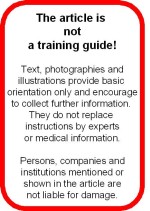1
Muscles for the Ballroom – Fitness Training for Dancesport:
The Chest.
Text: Kerstin Lange Photography and illustrations: Helmut Römhild
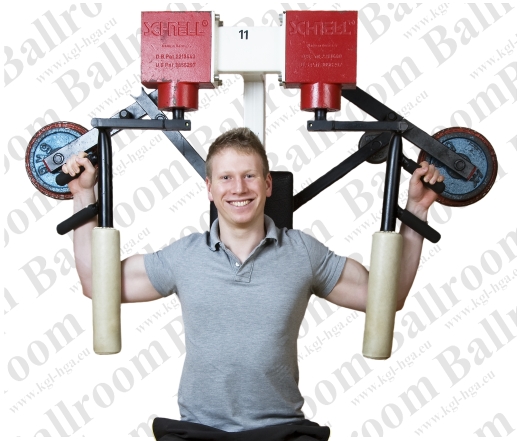
Chest muscle training with a ‘Butterfly’ exercise machine.
It is important that the machine pulls the arms slightly backwards, stretching the chest muscles.
Characteristic for the ballroom dancer is the straight, upright body – a posture used to control the position of the
center of gravity while moving across the floor.
The chest, pointing forward, is one of the basic elements of an optimal body shape.
‘Pushing out’ the chest means to pull the shoulderblades against the back of the ribcage, a job for the muscles on the back
and the side of the body.
So what really happens is that these muscles expand the chest.
Expanding the chest also involves the chest muscles – they have to give, as much as possible!
But very often they simply don’t – not only sabotaging the dancer’s effort to maintain balance but also making the dancer look, well, like a looser,
complete with with sagging shoulders, slouching and miserable.
The chest muscles can prevent the dancer from acchieving the optimal upper body posture.
Shortening is not an anomaly but a natural process caused by the specific structure of the muscles’ fibre.
It pulls the shoulders forward and downward and bends the back.
The tendency increases over time and also grows when the muscles become bigger and stronger: The stooped shoulders of many body builders and
boxers are the price which the athletes pay for their huge chests.
The dancer trying to expand the chest or to ‘push it out’ has to work against the chest muscles’ resistance.
The shorter the muscles are the stronger the resistance they offer.
The shorter they become the more power is necessary to acchieve and maintain a good upper body shape:
instead of controlling the posture the dancer is permanently fighting the chest muscles.
Workout in Dancesport.
The seemingly effortless way of ballroom dancers to move to the music is a result of considerable fitness. Already the basics of correct posture require strength and an optimised coordination of ligaments,
tendons and muscles.
Dancing alone is not enough to improve strength and mobility.
On the contrary: dancing means to make the system of muscles, tendons, and ligaments work for hours and hours, relentlessly
exploiting the individual possibilities and pushing beyond.
You have to work out to compensate the demands of your sport and to match your rising aspirations as a dancer.
In a short series of articles Ballroom will explain the anatomy involved and discuss exercises to improve
mobility, build up strength, and avoid injuries.
Fitness Trainer Ute Römhild, Trainer Assistant Marc Moder and model Martina contribute expert knowledge and show how to work out effectively.
Incorrectly performed exercises can damage your health!
Consult a fitness instructor before starting to exercise and exercise under supervision of a fitness instructor.
Expert advice is provided by Ute Römhild and Marc Moder.
Ute Römhild
Fitnesstrainer
TSV Glinde von 1930 e.V.
www.tsv-glinde.de
Marc Moder
Trainer Assistant
TSV Glinde von 1930 e.V.
www.tsv-glinde.de
The the pictures were taken at the fitness studio of sportsclub TSV Glinde. We are grateful for the generous support.
TSV Glinde von 1930 e.V.
www.tsv-glinde.de
There are 2 chest muscles, the large and the small chest muscle,
the pectoralis major and pectoralis minor. There is one of them on each side on the body’s front.
Only the large chest muscle is visible, giving the male chest its characteristic shape and covering the small chest muscle.
The large chest muscle consists of 3 parts: One originating from the collarbone, one from the sternum and the elastic tissue joining ribs 4 to 6, and one from the upper part of
the tissue which wrapps around of the long abdominal muscle, the rectus sheath.
The 3 parts come together at the bone of the upper arm.
The large chest muscle provides the necessary force for powerful arm movements like pulling, pushing, and ‘hugging’.
The small chest muscle also consists of 3 parts, attached to the 3rd, 4th, and 5th rib and joined at the outer upper edge of the
shoulderblade.
It pulls the shoulderblade forward and downward against the ribcage, providing stability.
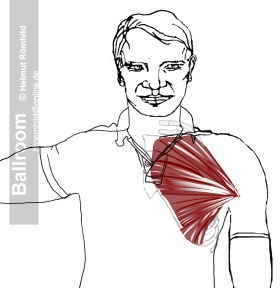
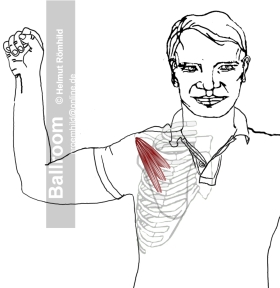
Stretching: A perfect way to a perfect posture.
Stretching means to expand the muscle even beyond the the normal length.
Stretching is more important than increasing the chest muscles’ strength and size because stretching is the only way
to counter the chest muscles’ tendency to become shorter.
A workout targeting the chest muscles’ flexibility combines contraction exercises with stretching because stretching is
regarded as most effective when directly combined with contraction exercises.
Stretching should be part of the exercise or done immediately after the workout.
If you are lucky you have access to a ‘Butterfly’ exercise machine which – after each forward push – pulls the arms slightly backwards, stretching the chest muscles.
Here’s a simple alternative:
Raise your arm to shoulder height and bend it. Rest your elbow against a doorframe, then move forward, carefully push the arm backwards.
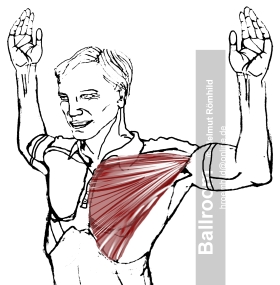
Chest muscle exercises to combine with stretching.
Remember that these muscles are used for powerful arm movements.
Exercises imitate ‘hugging’, pushing or raising/lowering the arms against resistance.
They focus on each of the 3 parts of the large chestmuscle, the small chestmusle is involved anyway.
You don’t need a machine to train the chest muscles.
| • | Swimming is the ideal way to train the chest muscles and is good for your basic fitness as well. |
| • | Push ups with your hands wider apart than the shoulders are a perfect exercise. |
| • | Use an elastic exercise band attached above your head to a door frame or the ceiling to do your downward pulls. |
Here’s how to make downward pulls on an exercise machine:
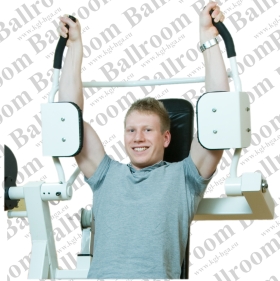
![]()
©: Ballroom Website, 2010
Updated: 27.12.2010

